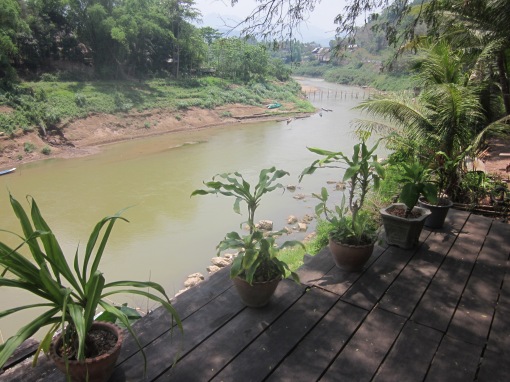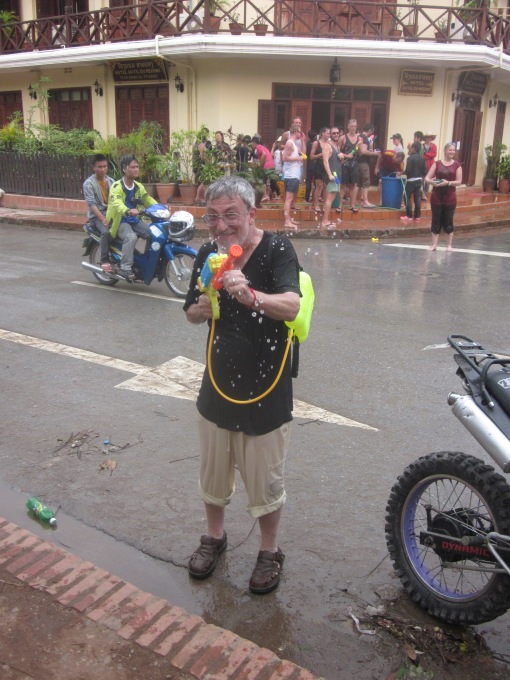LUANG PRABANG
April 12-13, 2012
Laos
The Siem Reap airport is a tiny design gem with beautiful shops and decor and sunlight. Our flight to Luang Prabang in northern Laos is very efficient and quick, with a stunning approach over steep mountains and muddy rivers that coil through the emerald countryside like serpents.
The visa formalities, unlike in Vietnam, are a snap, taking no more than five minutes. All the officials laugh and smile at everyone. When I misplace my passport photo for my visa, the customs officer smiles. “We will just scan it.” Laos is a Communist country, and B.J. and I were apprehensive about how strict the officials would be. No worries.
Laos, one of the poorest nations on earth, is a land of saffron-robed monks, misty valleys, stunning karst ridges, ethnic tribes, and too many elephants to count. We can’t wait.
The Kinnaly House in Luang Prabang, two blocks from the riverfront, was rated tops on the Internet, but it’s the least impressive of anyplace on our trip, both in terms of accommodations and service. Still, we can’t complain about the price: $18 a night.
We unload our bags and stroll into town. Luang Prabang, a UNESCO-protected peninsula of golden-sheened wats, crumbling French villas, and Scandinavian cafes, was once inaccessible. Today it’s been called everything from a Shangri La to the Pearl of the Orient to “the most beguiling ancient city in Southeast Asia.”
We stroll along the sleepy main drag, which follows a U-shape bounded by the Mekong and Nam Khan rivers below us. Crayon-colored longtail boats plow the river. Shops and outdoor cafes line the road, affording stunning views.
We stop and order a drink and watch a tangerine sun descend between two towering peaks in the distance as fisherman float across the water. This is a storybook land come to life. We cross the street and have dinner at Tamarind, which boasts a “Mod-Lao” cuisine. I order water buffalo steak, sticky rice, greens, and dipping sauces. We share a sampling platter of bamboo dip, stuffed lemongrass, herbs, and chilli pastes. I’m still thinking about it. Our best meal of the trip.
The next day B.J. gets up early and strolls the town while I sleep late. I rise, have mango pancakes on the riverfront, and rent a bike. I follow a long procession of people heading toward a stadium and carnival area. It’s the start of the Lao New Year, and the fun is about to start. How little do I realize just how much fun it will be.
Lao New Year is the most widely celebrated festival in Laos. It happens in mid-April, the hottest time of the year and the start of the monsoon season, lasting three days. Houses and villages are cleaned on the first day, and perfume, water, and flowers are prepared. The second day of the festival is the “day of no day,” a day that falls in neither the old year or the new year. The last day marks the start of the new year.
Water is used for washing homes, Buddha images, monks, and soaking friends and passers-by, with emphasis on the latter. The rituals actually serve an important role in Laotian culture — they aren’t only wishing a long and healthy life for themselves but wishing the same for others.
When I get back, B.J. is back in the room, and we watch with trepidation from the lobby what’s happening in the street. An endless line of cars, trucks, and motorcycles inch their way down the path while hundreds of people with hoses, buckets, and water guns assault them.
I look at B.J. Our shopping and sightseeing plans for the day just evaporated. “If you can’t beat ’em…” We go upstairs, change into our bathing trunks, and wade into the chaos.
We’re drenched to the bone within seconds. In the stifling heat, it’s actually welcome. It’s hard not to throw yourself into the melee, and we do. We hook up with a rowdy group holding fort on one corner. Across the street an even more malevolent group charges us continually and we repel them back as best we can. It doesn’t matter who’s winning or losing; it’s a ton of fun. When huge open-bed trucks filled with party-goers approach, our teams forget our mutual rivalry and turn our attention to the intruders, descending on them with vengeance.
The melee continues until well after dark. When it finally subsides and we feel safe enough to venture out with dry clothes, we head for the Night Market along the main street. Hundreds of Hmong women have set up stalls beneath tents lit by bulbs that glow magically like strings of red lanterns. It’s the best selection of handmade souvenirs we find during our trip.
VANG VIENG
April 14, 2012
Laos
We say farewell to lovely Luang Prabang and take a bus six hours south to the riverside village of Vang Vieng along the Nam Song River. We’ve come here because of the fabled mist-shrouded karst mountains.
The road takes us high, high, and higher into enormous mountain forests, dolloped with dirty, dusty wooden towns that look like Wild West throwbacks. Even way up here, our bus is pelted by kids with water guns and buckets. They remind us that we have two more days of this to look forward to.
Vang Vieng is in the midst of a water holocaust when we arrive, and it looks like the revelry has destroyed the place. Only later do we discover that that’s the way it looks all the time.
The city was first settled in 1353 as a staging post between Luang Prabang and the capital Vientiane. The town expanded during the Vietnam War when the U.S. developed an Air Force base and runway that was used by Air America.
We read that the town has lost much of its original charm due to drunken tourists, unsafe water sports, and happy mushroom shakes. The New Zealand Herald wrote, “If teenagers ruled the world, it might resemble Vang Vieng.” Last year, 22 tourists died on the river while inner tubing. Inner tubing? Good grief.
When we venture out, we’re confronted by a dirty, seedy, crumbling street inhabited by a melange of what look like Rastafarians, Jesus impersonators, expats, backpackers, mercenaries, and escaped criminals. And all are armed — with Rambo-size water cannons. I hope that’s all they’re packing.
We avoid the mayhem and slip down to the water. There we behold why Vang Vieng is such a stunning place — after you evict all the tourists. A rickety wooden footbridge, barely erect on wobbly heron-thin poles, spans the Nam Song River puttering with fishermen and kayaks.
Above the glassy water, multihued balloons silently float over us. Across the water is a limestone karst mountain range that must have been transplanted from Jurassic Park, its layers of towering ridges eroded over millions of years into fantastic shapes. A Chinese water color.
VIENTIANE
April 15, 2012
Laos
We decide to head for the capital the next day. Over the years, Vientiane has been occupied by the Vietnamese, Burmese, Siamese, and Khmers. In the 19th century, the French colonized the country and turned the city into one of Indochina’s grand metropolises. In the early 1960s it teemed with CIA agents and Russian spies.
Eleven of us jam into a van for the four-hour drive to the capital. It’s one of the worst rides of my life. The first three hours are hell, as the road is nothing but potholes and rocks. We’re slammed and bumped and rocked nonstop. I keep expecting our vehicle to break down, but it miraculously holds together. During the last hour, as we near the capital, the road is semi-passable. We arrive in the afternoon to, surprise, water fights. In the capital, the frenzy seems to be ramped up tenfold with seemingly every block a war zone.
Our guesthouse, Mali Namphu, is wonderful, with a large room, a stunning garden courtyard, and impeccable service. B.J. is beat and takes a nap, not wishing to get wet again. I throw on my bathing trunks and head down to the riverfront.
I find the Mekong, but the water level is so low that it looks like a dry riverbed. And nothing is built along the riverbank. No hotels, cafes, shops. No trees or shade. Nobody’s strolling. The sun is bearing down fiercely, so I hurry away to where music is blaring.
A concert is in progress. A live band is in full swing, sprinklers on the stage are soaking the crowd, and everyone’s jumping and dancing. I join in and dance myself ragged for an hour, then stagger away. The water fights are much wilder here than in the provinces.
I come across an off-the-wall group dancing atop trucks, atop trash cans, rolling and spinning in the puddles like street acrobats. It looks like an audition for Step Up 4. These kids are smoking. I join them, and we rock and splash the street for the next three hours. Soon people are leaping off their trucks to join us. We grow in size until we’ve morphed into a Soul Train street party, Laotian style.
It’s a fitting end to a wet and wild Laotian holiday. We enjoy our short glimpse of this mysterious country. Its beauty is unrivaled but unfortunately so is its poverty. It’s doing better these days due to its burgeoning tourist industry, but the resulting influx of foreigners has begun to erode many of its charms. No telling what the future holds for this tiny nation of 7 million.
Next and final stop: Thailand.




